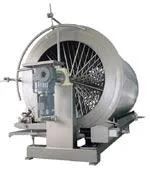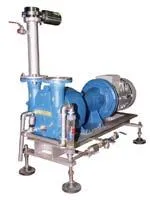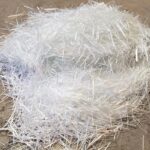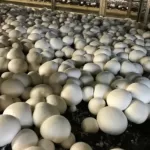Start a Yeast Manufacturing Unit
What is Yeast?
Yeast are single-celled fungi. As fungi, they are related to the other fungi that people are more familiar with, including: edible mushrooms available at the supermarket, common baker’s yeast used to leaven bread, molds that ripen blue cheese, and the molds that produce antibiotics for medical and veterinary use.
Yeast cells are egg-shaped and can only be seen with a microscope. It takes 20,000,000,000 (twenty billion) yeast cells to weigh one gram, or 1/28 of an ounce, of cake yeast.
A tiny organism with a long name
The scientific name for the yeast that baker’s use is Saccharomyces Cerevisiae, or “sugar-eating fungus”. A very long name for such a tiny organism! This species of yeast is very strong and capable of fermentation, the process that causes bread dough to rise.
A fungus with a sweet tooth
Yeast cells digest food to obtain energy for growth. Their favorite food is sugar in its various forms: sucrose (beet or cane sugar), fructose and glucose (found in honey, molasses, maple syrup and fruit), and maltose (derived from starch in flour).
The process, alcoholic fermentation, produces useful end products, carbon dioxide (gas) and ethyl alcohol. These end products are released by the yeast cells into the surrounding liquid in the dough. In bread baking, when yeast ferments the sugars available from the flour and/or from added sugar, the carbon dioxide gas cannot escape because the dough is elastic and stretchable. As a result of this expanding gas, the dough inflates, or rises. Thus, the term “yeast-leavened breads” was added to the vocabulary of the world of baking.
The ethyl alcohol (and other compounds) produced during fermentation produce the typical flavor and aroma of yeast-leavened breads.
Fermentation in nature
Fermentation occurs naturally in nature. For instance, many berries break open in late fall when they are overripe and full of sugar. Natural yeast organisms, so small they cannot be seen with the naked eye, lodge on the surface of these berries, which then become fermented and alcoholic.
Yeast in History
Yeast can be considered man’s oldest industrial microorganism. It’s likely that man used yeast before the development of a written language. Hieroglyphics suggest that the ancient Egyptian civilizations were using yeast and the process of fermentation to produce alcoholic beverages and to leaven bread over 5,000 years ago. The biochemical process of fermentation that is responsible for these actions was not understood and undoubtably looked upon by early man as a mysterious and even magical phenomenon.
Leaven, mentioned in the Bible, was a soft, dough-type medium kept from one bread baking session to another. A small portion of this dough was used to start or leaven each new lot of bread dough.
It is believed that since early times, leavening mixtures for bread making were formed by natural contaminants in flour such as wild yeast and lactobacilli, organisms also present in milk.

Yeast Today
It was not until the invention of the microscope, followed by the pioneering scientific work of Louis Pasteur in the late 1860’s, that yeast was identified as a living organism and the agent responsible for alcoholic fermentation and dough leavening. Shortly following these discoveries, it became possible to isolate yeast in pure culture form. With the newfound knowledge that yeast was a living organism and the ability to isolate yeast strains in pure culture form, the stage was set for commercial produciton of baker’s yeast that began around the turn of the 20th century.
TYPES OF YEAST
When you hear the word “yeast”, what do you think of? No doubt you think of the type of yeast used in baking breads.
However, through the selection of strains and development of propagation techniques, more specific applications of yeast are now being found in many different industries, including brewing, malting, farming (animal feeds), pharmaceuticals and dietetics.
The three types of yeast we will explore:
● Baker’s Yeast
● Nutritional Yeast
● Brewer’s Yeast
●
Yeast IndustryThe yeast industry is the oldest in the field of biotechnology. It is a high-tech industry which has benefited from many scientific advances.
Its products are the result of ongoing research and development. The classical genetics technology has ensured the adaptation of the strains to the needs of the European bakery market and also to those of the whole world.The culture processes has improved due to using the best knowledge of biology and cell physiology. A perfect command of raw materials and manufacturing technique, advanced automation, together with logistics monitoring guarantee the quality of products.The yeast industry is a heavy industry, meaning capital dependent, requiring an investment of 3 euros to get a turnover of 1 euro.
MANUFACTURING OF YEAST
The manufacturing process for yeast can be likened to farming – it involves preparation, seeding, cultivation and harvesting.
As you learned in The Story of Yeast, the favorite food for yeast is sugar. In the commercial production of yeast, molasses is used to provide this sugar source. Molasses is a by-product of the refining of sugar beets and sugar cane. Either cane molasses or beet molasses can be used, however, some yeast manufacturers prefer a mixture of the two varieties.
Quality Assurance
In all the yeast processes, utmost care is taken to produce a product of the highest possible quality and purity. Samples are routinely checked by the laboratory and frequent cleaning and sterilization of the equipment are conducted to assure the proper standards are met.

Preparation
Before feeding molasses to the yeast cells, it must be clarified and sterilized. This is done in order to assure the final yeast color. The sterilizing also prevents bacteria and other organisms from being introduced during manufacturing.
The molasses is then diluted with water, adjusted for acidity, heated until almost boiling and filtered through heavy clothes.
Seeding
The seed yeast is a carefully maintained laboratory culture so as to avoid contamination by “wild” yeast present in the air. Yeast seeds are selected with care according to the type of yeast to be produced and the specific characteristics desired. All cultures are laboratory pure; all transfers are made with absolute sterility; all vessels are completely sterilized.
The “seed yeast” is placed in small flasks where it is allowed to grow. It is then transferred in a series of steps from these small flasks to tanks of about 1,000 gallons in volume. Now known as “stock yeast”, it is separated from the alcohol generated by the fermentation and stored in refrigerated tanks for the subsequent fermentation cultivation.

Cultivation
The cultivation or advancement of the fermentation process is accomplished in large 40,000-gallon vessels. It is impractical at this point to sterilize such large vessels but careful cleaning with steam assures cleanliness and quality.
The “stock yeast” is fed measured quantities of molasses and large quantities of air. The temperature is carefully controlled and acidity (pH) frequently adjusted through the addition of ammonium salts. This process is continued until the yeast achieves the capacity of these 40,000-gallon fermenting tanks. The yeast is then harvested.

Harvesting
The harvesting of yeast is nothing more than concentrating the yeast cells by passing the fermented liquid through large centrifugal pumps called “separators”. This process is similar to spinning clothes dry in a washing machine. The result is an off-white liquid called “cream yeast”. Further processing/drying is dependent on the type of yeast desired – cake yeast, active dry yeast or instant yeast.

Plant and Machinery
The list of plant and machineries / utilities required for production of 10 MT per day finished product is
summarized in following table:
List of Plant and Machinery Particulars Quantity Suppliers
1. Molasses Storage & Sterilization 4 Tanks 4 Praj Industries, Pune
2. Twin lobe air blower/compressors
(8-10 psi) & filters 1 Ingersol-Rand India Ltd, Ahmedabad
3. Diesel generating set to runstirrers in
fermentation tanks 2 Super Nova Engineering- Chhatral
4. Boiler Oil fired 1 Thermax Ltd, Pune
5.Heat exchanger 2 Praj Industries, Pune
Alfa-Laval Ltd, Pune
6.Refrigeration unit for freezedrying of yeast 1 Frick India Ltd- New Delhi
7 Centrifugal separator 4 Alfa-Laval Ltd, Pune
8.Extruder 2 Campbell WrapperMachinery,AndhraPradesh
9. Electricals Lot Kirloskar Electric Co. Ltd., Karnataka
10.Piping, Pumps, Valves Lot R.R Industries, New Delhi
11.D.M Plant 1 Doshi-ion exchange P. Ltd.
12.Effluent Treatment Plant 1 Akar Impex Private Limited, Noida
Oilex Engineers (India) Pvt Ltd., Mumbai
13.Laboratory equipments Lot Sakova Scientific Co., Mumbai
Equipment for the production of Fresh Yeas
Rotary Vacuum Filters  For dehydrating yeast cream for the production of fresh yeast, instant yeast and active dry yeast. Standard sizes: 4, 6, 9, 12, 15 and 18 sq. m. Sanitary and easy-to-clean design. The automation systems make the Rotary Filter start and stop automatically following a preset program, according to the filling level in the mixer hopper of the Extruder. Very high outputs are obtained. Moreover, the dry matter of the produced yeast can be adjusted between 28 % and 34 % for fresh yeast and up to 40 % for instant yeast. We supply complete and automatic systems, including all ancillary and automation units, such as: For dehydrating yeast cream for the production of fresh yeast, instant yeast and active dry yeast. Standard sizes: 4, 6, 9, 12, 15 and 18 sq. m. Sanitary and easy-to-clean design. The automation systems make the Rotary Filter start and stop automatically following a preset program, according to the filling level in the mixer hopper of the Extruder. Very high outputs are obtained. Moreover, the dry matter of the produced yeast can be adjusted between 28 % and 34 % for fresh yeast and up to 40 % for instant yeast. We supply complete and automatic systems, including all ancillary and automation units, such as:  Intermediate cream and precoat preparation tank, with yeast cream saltingsystem in line and automatic cream feeding system to the Rotary Filter. Intermediate cream and precoat preparation tank, with yeast cream saltingsystem in line and automatic cream feeding system to the Rotary Filter.  Control box with touch screen for controlling and adjusting the Rotary Filter. The control and adjustment of the Rotary Filter can also be made from the touch screen of the fresh yeast Packaging Line or from the touch screen that can be installed near the Noodle Extruder, for the production of instant yeast. Thanks to this control system and the equipment and automation degree of our machines, no operator is required during the automatic filtration process of the Rotary Filter. Control box with touch screen for controlling and adjusting the Rotary Filter. The control and adjustment of the Rotary Filter can also be made from the touch screen of the fresh yeast Packaging Line or from the touch screen that can be installed near the Noodle Extruder, for the production of instant yeast. Thanks to this control system and the equipment and automation degree of our machines, no operator is required during the automatic filtration process of the Rotary Filter.  Motor-vacuum pump unit, optionally also made of stainless steel. Special design according to the operation conditions this equipment is submitted to. With non-cavitation valve of Proconor design and automatic water supply system to the liquid ring. Motor-vacuum pump unit, optionally also made of stainless steel. Special design according to the operation conditions this equipment is submitted to. With non-cavitation valve of Proconor design and automatic water supply system to the liquid ring.  Water supply system to the washing system, including automation device for shutting and opening the water supply. Noodle Extruders Machines and equipment required between the discharge of yeast at the Rotary Filter and the loading of the yeast noodles into the Dryers, amoung which we would like to point out: Water supply system to the washing system, including automation device for shutting and opening the water supply. Noodle Extruders Machines and equipment required between the discharge of yeast at the Rotary Filter and the loading of the yeast noodles into the Dryers, amoung which we would like to point out:  Mixer-Extruders for extruding yeast noodles with 0.5 mm diameter or more, for the production of instant yeast and active dry yeast. Availability of 2 machine sizes to suit the production requirements and operation cycle of the Dryers, as detailed below: * Model CP-AEF/2500. Production capacity of 2,500 kg/h * Model CP-AEF/5000. Production capacity of 5,000 kg/h. Mixer-Extruders for extruding yeast noodles with 0.5 mm diameter or more, for the production of instant yeast and active dry yeast. Availability of 2 machine sizes to suit the production requirements and operation cycle of the Dryers, as detailed below: * Model CP-AEF/2500. Production capacity of 2,500 kg/h * Model CP-AEF/5000. Production capacity of 5,000 kg/h.  Mixing Systems to mix the emulsifiers with the yeast. Two different sizes (for the production of 2.5 t/hour and 5 t/hour), as well as different automation possibilities for the discharge, according to the layout of the whole system. Mixing Systems to mix the emulsifiers with the yeast. Two different sizes (for the production of 2.5 t/hour and 5 t/hour), as well as different automation possibilities for the discharge, according to the layout of the whole system.  System to add, control and adjust the emulsifiers that are added to the yeast at the Rotary Filter outlet. System to add, control and adjust the emulsifiers that are added to the yeast at the Rotary Filter outlet. |


